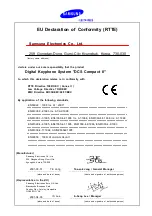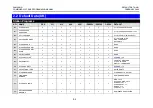
SAMSUNG
INTRODUCTION
COMBINED SYSTEMS PROGRAMMING MANUAL
FEBRUARY 2004
1–2
Programming requirements for these system types are broadly similar, but occasionally
there are differences. Not all MMCs apply to all systems, and options available in a given
MMC for one system may not be available to another. Bear in mind when programming
your system, therefore, that
some of the options listed for an MMC may not appear on
your system
.
Users of 408 and 408i systems should also read section
The different system types are discussed fully in the separate
Samsung General De-
scription
manuals for each system, where these have been published.
Tenant Programming
OS500,
i
DCS500 and DCS (excluding CI) systems support two “tenants” which can be
separately programmed with different customer data. All other systems support a single
tenant only.
Software Version Numbers
The features described in this manual refer to the most recent software versions. Older
software versions may not contain all the features or options listed.
1.3 Programming Overview
When the telephone system arrives from the factory it contains default data. This needs
to be customised, using the MMC programs, to suit the customer’s requirements.
Each MMC (Man Machine Code) is assigned a 3-digit code, 100, 101, and so on. These
MMCs are used to view, create or change customer data on a display keyphone. This is
called KMMC programming.* For example, MMC 601 is used to create a station group;
system speed dial numbers are entered in MMC 705; and key functions are assigned to
individual keyphones (or “keysets”) using MMC 722.
* Note: PCMMC programming (not covered in this manual) refers to system programming via a
PC.
1.4 Programming Levels
There are three levels of programming: System level, Customer level and Station level.
System and Customer levels allow system-wide programming and are under passcode
protection to restrict access. System programming is done by the system installer (or
system technician), usually on a one-off basis, but also to manage any changes in the
customer’s requirements. Customer programming is done by the system administrator,
on a day to day basis, to manage station users’ requirements. Station level programming
does not require a passcode, allowing station users to make simple changes to their own
keysets.
To prevent conflicting data from being entered, only one person at a time can enter Sys-
tem or Customer programming. If you attempt to enter programming mode while another
keyset is being used for programming, your display shows [xxx PGM MODE] where “xxx”
is the keyset extension number of the station in programming mode.
While programming is in progress, normal system operation is not affected.













































